Kato Chicago Burlington & Quincy EMD E5A Locomotive
Published: 2024-02-01 - By: CNW400
Last updated on: 2024-02-24
Last updated on: 2024-02-24
visibility: Public - Headline

The Prototype
The Silver Streak Zephyr was a daily 250-mile train route offered by the Chicago Burlington and Quincy Railroad from 1940 until 1959. The approximate five-hour journey operated between Lincoln, Nebraska and Kansas City, Missouri (with stops in Omaha, Nebraska and St. Joseph, Missouri) was originally led by the newly designed Electro-Motive Division (EMD) E5A diesel locomotive #9909 – Silver Bullet.
The EMD E5 locomotives were produced in 1940 and 1941 at the General Motors Electro-Motive Division of LaGrange, Illinois solely for use by the Chicago Burlington and Quincy and their subsidiaries (Colorado and Southern Railway & Fort Worth and Denver Railway). The gleaming stainless-steel streamlined engines were specifically designed with a shiny ribbed silver body to coordinate with their corrugated Budd Company service cars. The stainless-steel body was resistant to corrosion and the lightweight construction was a fuel saver. The eye-catching composition also created curiosity and a boost to Burlington Route passenger service revenue when railroads were beginning to experience a decline in ridership. The E5 was the sixth installment in the EMD E-unit series with 2,000-horsepower and top speed of 116 mph. The ‘E’ had originally specified an 1,800-horsepower engine in the EMD production line. Electro-Motive Division (EMD) produced a total of 11 ‘cab-units’ and 5 'booster-units’ in the E5 classification.

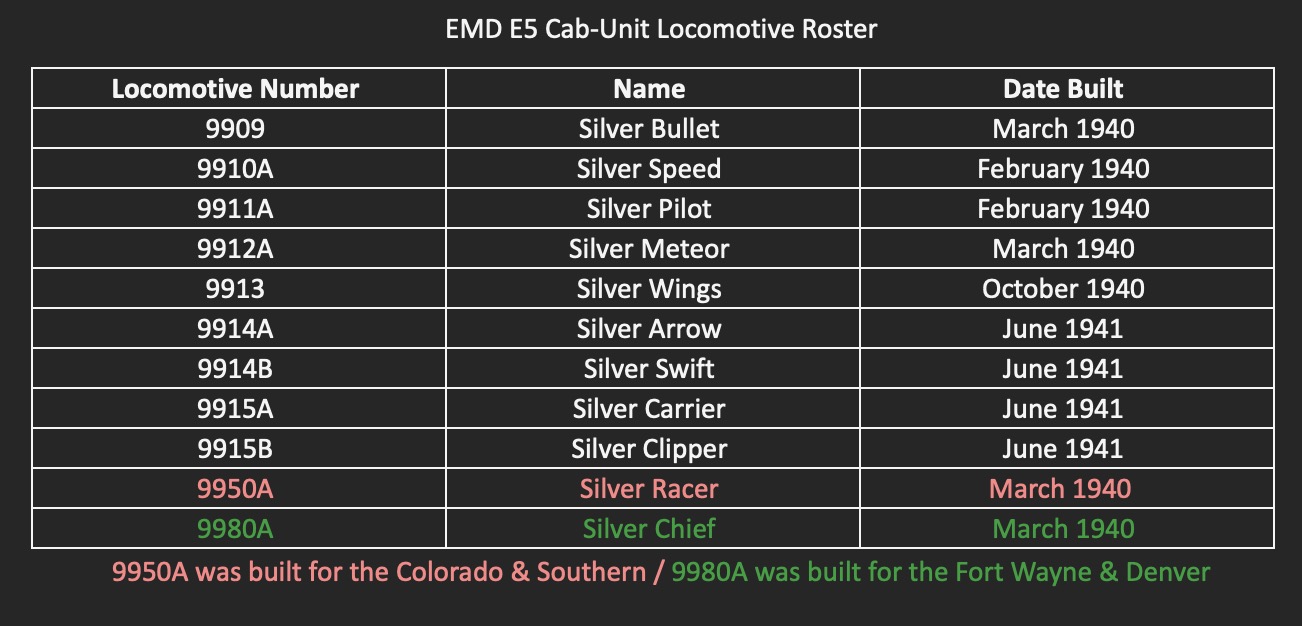

Allegedly named after the 1934 RKO motion picture The Silver Streak which featured a loosely based story on the Burlington Route’s Pioneer Zephyr speed record and its race to save a dying man – The Chicago Burlington and Quincy Silver Streak route was launched on April 15, 1940. * The E5A #9909 Silver Bullet locomotive pulled a consist of five streamlined fluted-side cars. The silver corrugated with black lettering railcars on this route included: Baggage Car #900 (Silver Light), Baggage/RPO Car #1600 (Silver Sheen), two fifty-two seat Coach Cars #4703 (Silver Gleam) /#4704 (Silver Glow) and twenty-four dining seat/twenty-two revenue seat Observation Car #300 (Silver Spirit) with an illuminated tail sign. The train set was made with non-articulated equipment as the Burlington Route was moving away from to use of articulated passenger railcars. *Some refute this claim and insist the name was the product of an internal marketing contest.

The E5A units were 71-feet long, 10 ½-feet wide, and 15-feet tall...weighing about 315,000 pounds. The locomotive featured a distinctive sloping nose design with a thick black three stripe pattern across the entire width of the nose. Additionally, it was furnished with dual headlights – including a gyrating Mars signal light mounted in the lower lamp position. The nose also featured black grill patterns on both sides of the headlight, the Burlington Route logo, and a pilot door to allow front coupling for a two-unit A-A power supply – Chicago Burlington and Quincy regularly ran their E5-units both forward facing...elephant style.
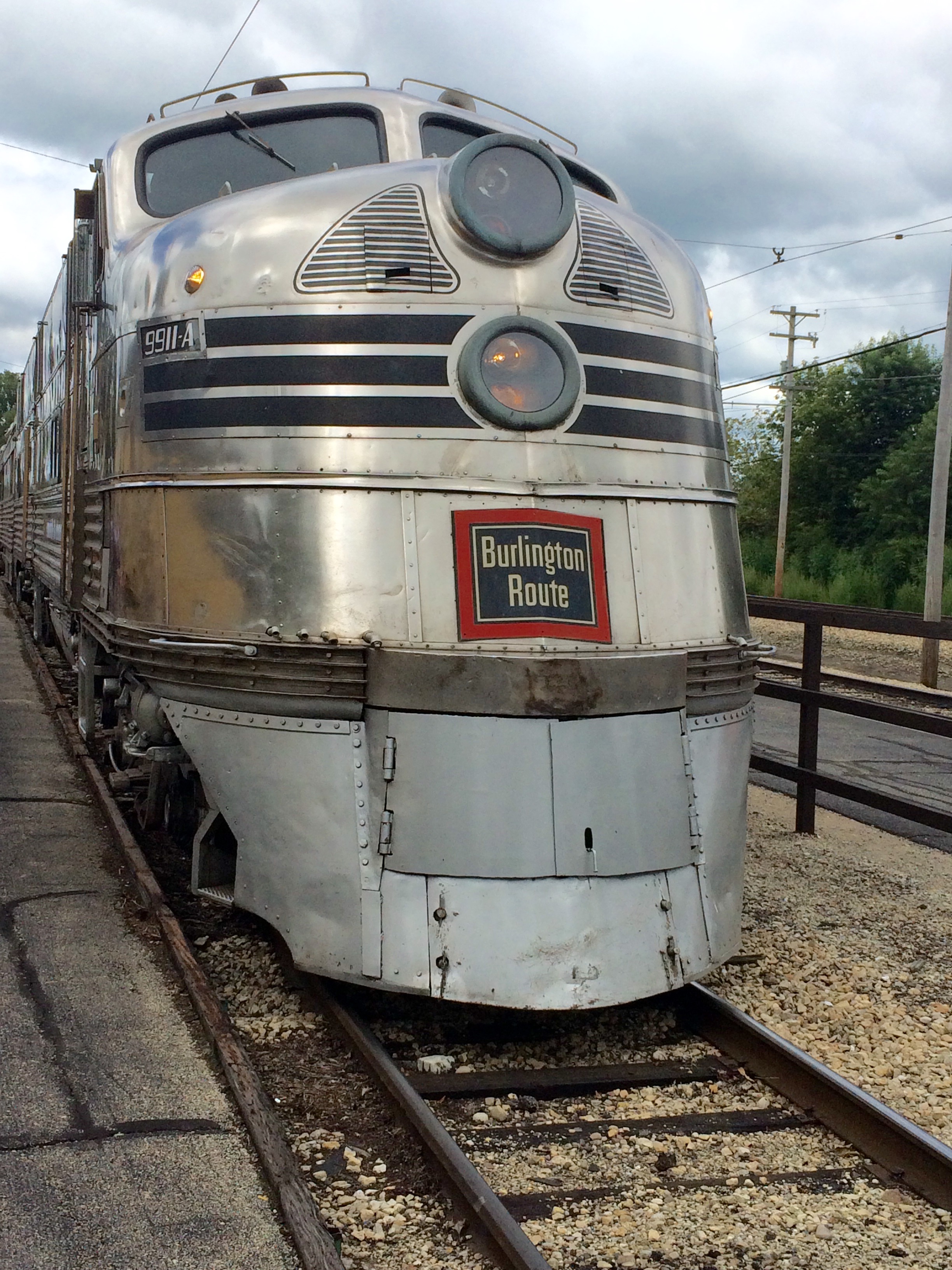
By the mid-1950s, the lifespan of the E5 units came to an end with the introduction of the EMD SD-9 (1954), EMD SD-24 (1958), and EMD GP-20 (1959). Burlington Route sold five of their E5 units to their subsidiaries by 1957. Two more units were destroyed in separate wrecks while the others were either traded-in to EMD or GE towards new purchases or simply scrapped.
Although I have found conflicting dates for exactly when – the black striping on the nose for the six remaining E5 units in Burlington Route control were changed to red and name plates removed sometime during the early 1960s... coinciding with the introduction of the Burlington Route’s ‘Chinese Red’ color scheme. The only surviving EMD E5 unit is #9911A – Silver Pilot. Preserved in operational condition, it is one of the jewels at the Illinois Railway Museum (IRM) in Union, Illinois. Acquired directly from EMD in 1968, the Silver Pilot pulls the IRM’s 1936 Nebraska Zephyr five-car stainless steel set that is regularly on display and running at the museum.
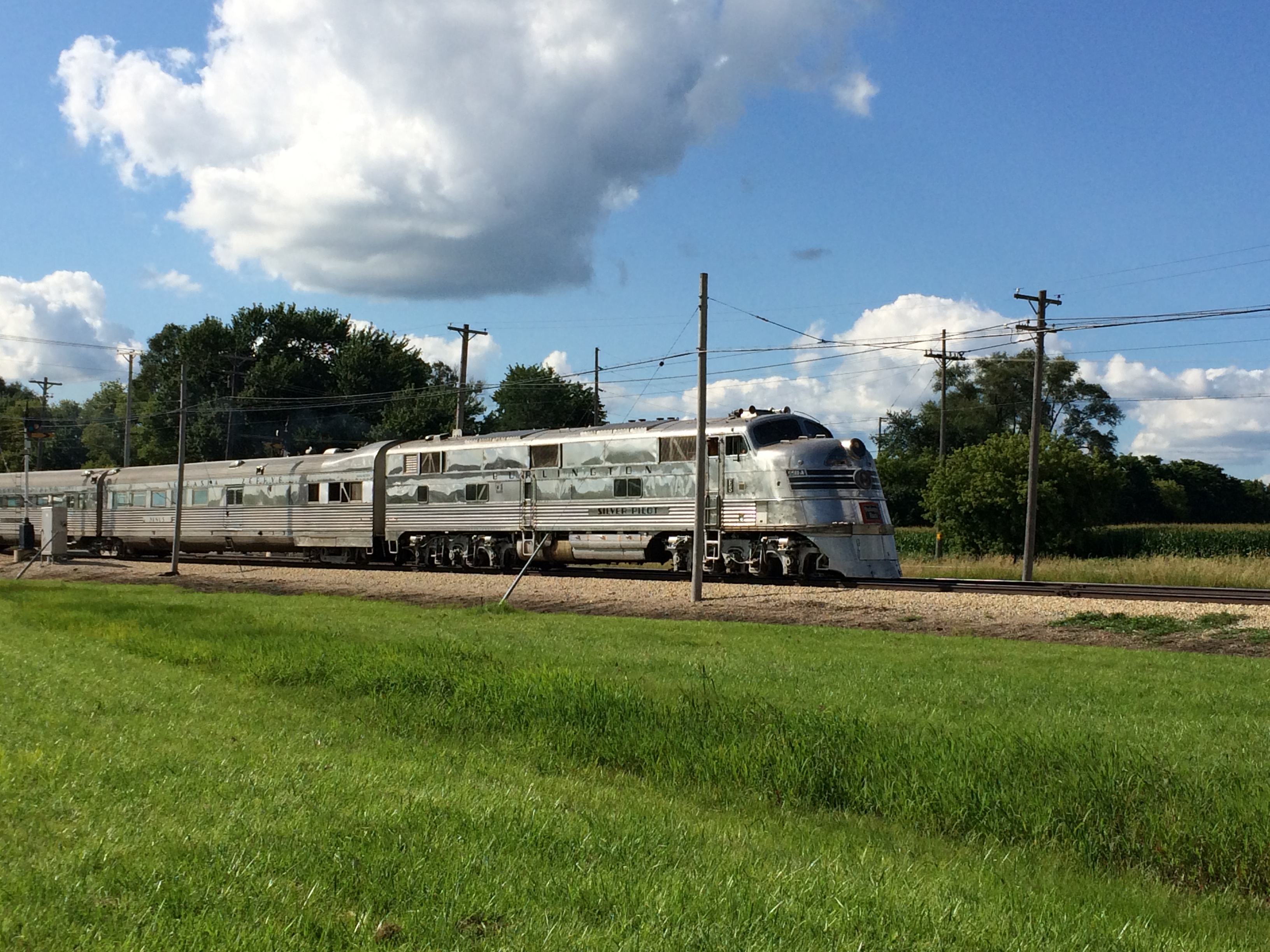
Road Names and Pricing
This month I will be revisiting an old friend – the Kato Precision Railroad Models Electro-Motive Division (EMD) E5A diesel locomotive. The glistening stainless steel engines were exclusively manufactured for the Chicago Burlington and Quincy Railroad in the 1940s. The fall of 2017 marks the most recent Kato release of individual locomotives – made available in DC, DCC and installed ESU LokSound variants. Kato reissued the popular 2012 ‘Silver Streak – Way of the Zephyrs’ six-unit bookcase set in October of 2023. The EMD E5A engines produced by Kato include:- Burlington Route #9909 Silver Bullet
- Burlington Route #9910A Silver Speed
- Burlington Route #9911A Silver Pilot (Illinois Railway Museum with Red Band)
- Burlington Route #9912A Silver Meteor (1960’s Red Band Version)
The Model
Individual locomotives are delivered in the familiar green sleeved Kato plastic jewel case. A piece of bubble wrap protects the engine from scuffmarks and a thick foam insert cradles the locomotive from damage. A plastic bag holds the optional coupler trip pins and Kato magnetic knuckle coupler if the user desires to remove the pilot door and install a front coupler.
If the ‘Way of the Zephyrs’ set was ordered - the six-unit compilation is packaged in a foam cushioned bookcase holder with a handsomely decorated cardboard sleeve. The cars are covered with a thin plastic ‘bubble wrap’ sheet to protect from damage during the shipping process. Also included in the case is an information sheet and a small package with an additional Kato magnetic knuckle coupler and coupler trip pins if the model owner wishes to use.
The nose of the Kato E5 model faithfully captures the majestic beauty of this unique locomotive. The distinctive engine is decorated with an ‘as delivered’ three wide black stripe pattern and black grill line configuration next to the headlight. This color motif was replaced with red stripes during the Burlington Route’s Chinese Red era during the 1960s. The dual headlights are correctly positioned with golden white LED lights with the stationary light mounted above the Mars signal lamp. The preprinted number boards also illuminate and are correctly labeled 9909.
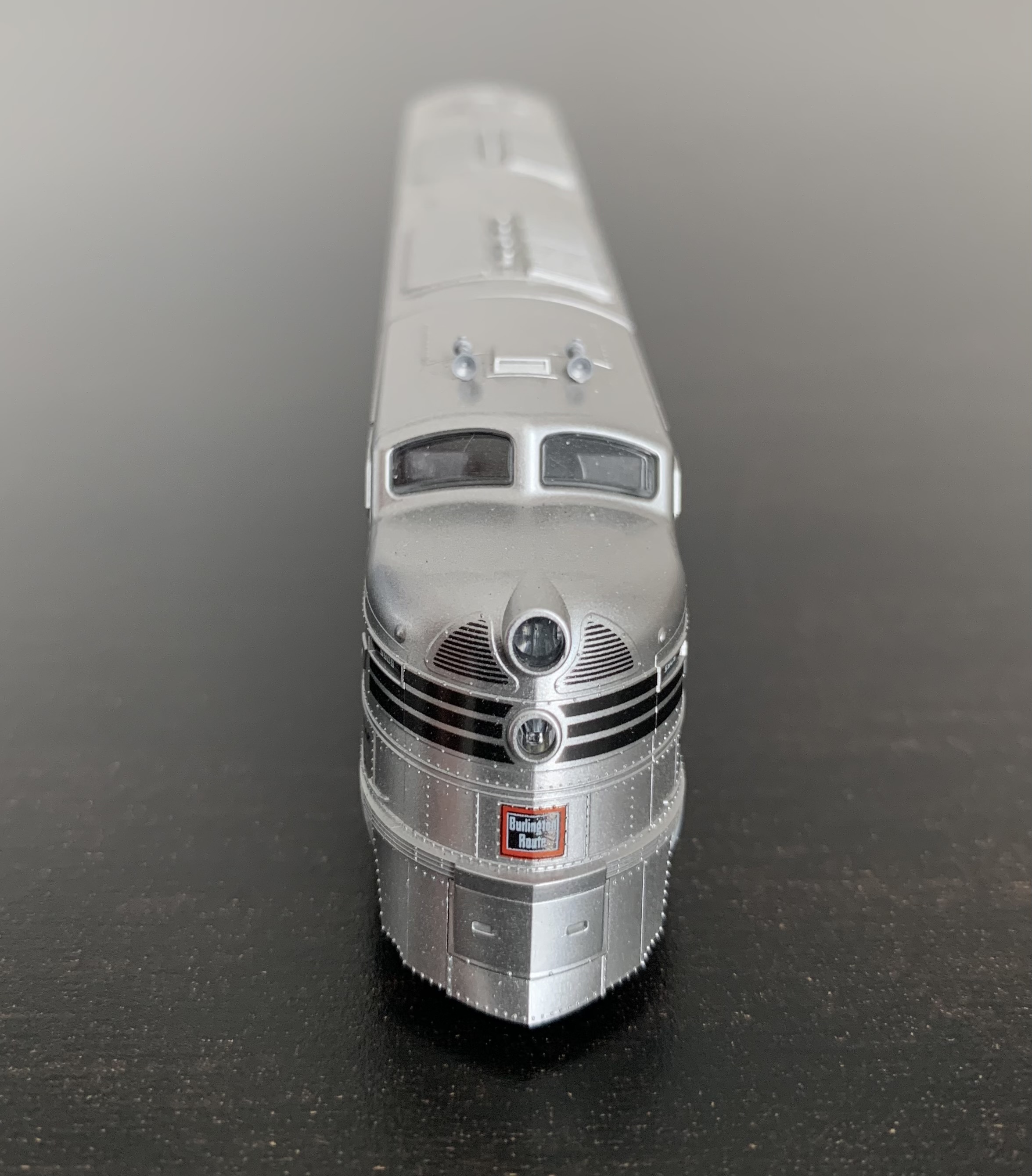
Sharp rivet lines highlight the slanted nose contour of the EMD E5 locomotive. The front coupler cowling may be removed to install a factory supplied Kato magnetic knuckle coupler to double head (use of two locomotives at the front of the train for additional motive power) a pair of locomotives. If left intact, the pilot displays the slots for the MU (multiple unit) lash-up hoses. Lastly, the red and black Burlington Route logo is properly shown with screw or bolt lines on all four sides of the panel.
The simulated stainless steel plate job is clean and even along the entire injection molded plastic model. All black lettering is neat and sharp – and in the proper location for this Phase One E5 locomotive. Per Federal law, the letter ‘F’ was placed under the Silver Steak name to designate this as the front of the train. This rule was put into practice to assist crews during switching as to which end was forward facing with the introduction of long-hood and short-hood diesel locomotives.
Furthermore, the sides exhibit fluted or corrugated lower panels to match the Budd Company Zephyr passenger cars. The Kato model also displays the prototypical correct 2-1-2-1 window arrangement with interior views of the prime mover. Three see-through metal etched side vents run along the top sides of the engine. This early example of the EMD E5 locomotive includes the Phase One truck skirting. The skirts proved to be a nuisance during maintenance and were later excluded on later versions of the E5 locomotive. Kato has also accurately depicted the early versions of this engine with the correct position of the cut lever and the omission of the E5 label below the side cabin windows. This panel was added during the 1960s color change scheme.
Kato has made available both the Early Version E5 models with black highlights and skirted trucks and the Late Version with red color scheme and non-skirted trucks.

The top of the locomotive impressively displays the unique E5 elevated radiator grills with vertical lines. EMD created this grill configuration for use solely on the E5 series. Eight diesel engine exhaust arrestors are aligned in the center of the roof. Lasty, separately applied dual horns are positioned above the cabin – a Leslie Tyfon A-200-156 and Leslie Tyfon A-200-233 horn were typically found on these engines.
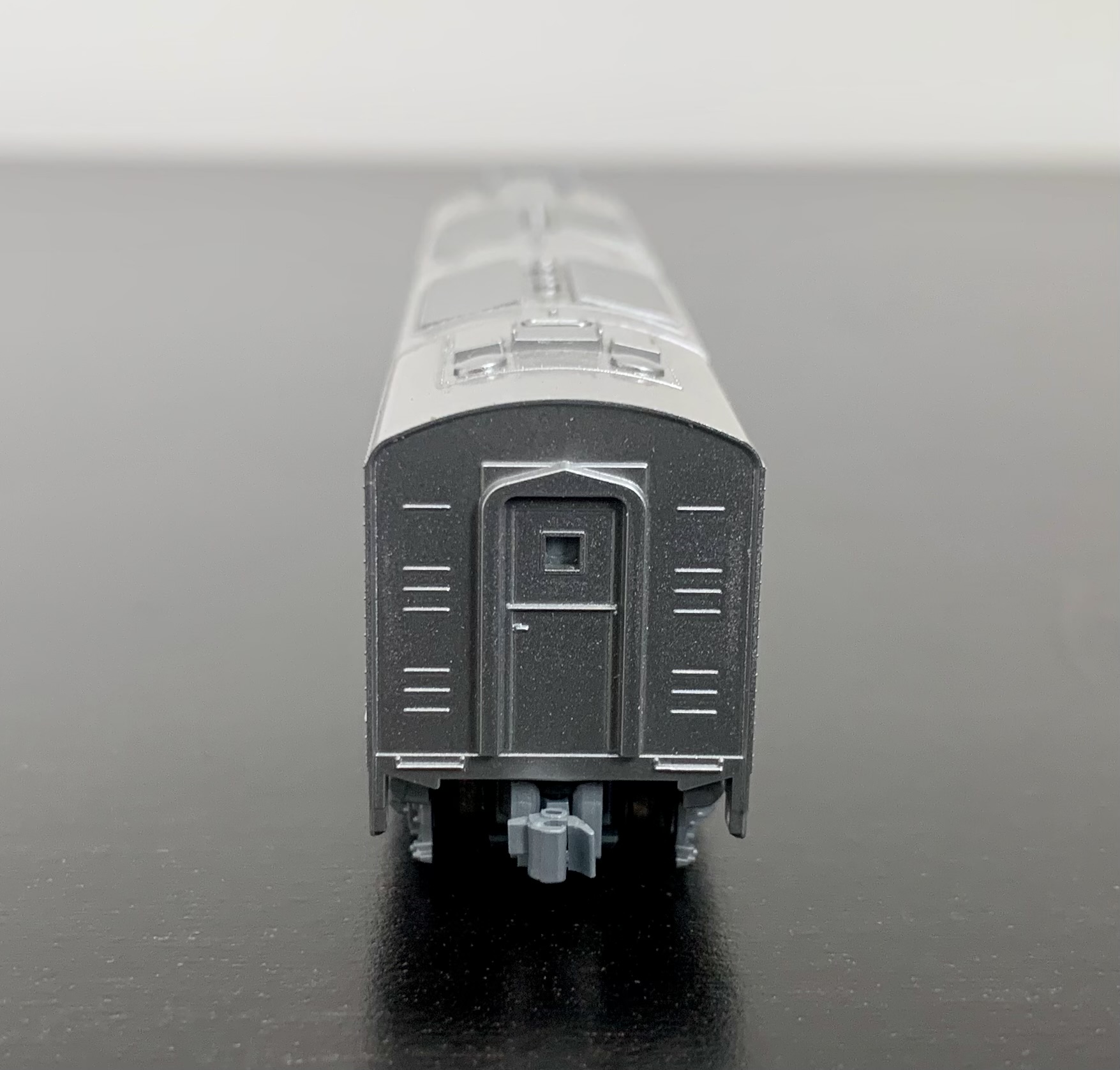

The rear of the train is uninspired with a molded door and poorly designed diaphragm. The underside features blackened metal wheels running on EMD A-1-A Blomberg skirted trucks with early version bearing covers and speed recorder. The rear features a body-mounted magnetic knuckle coupler that was measured at the correct height. *Note the location to install the optional forward-facing coupler.
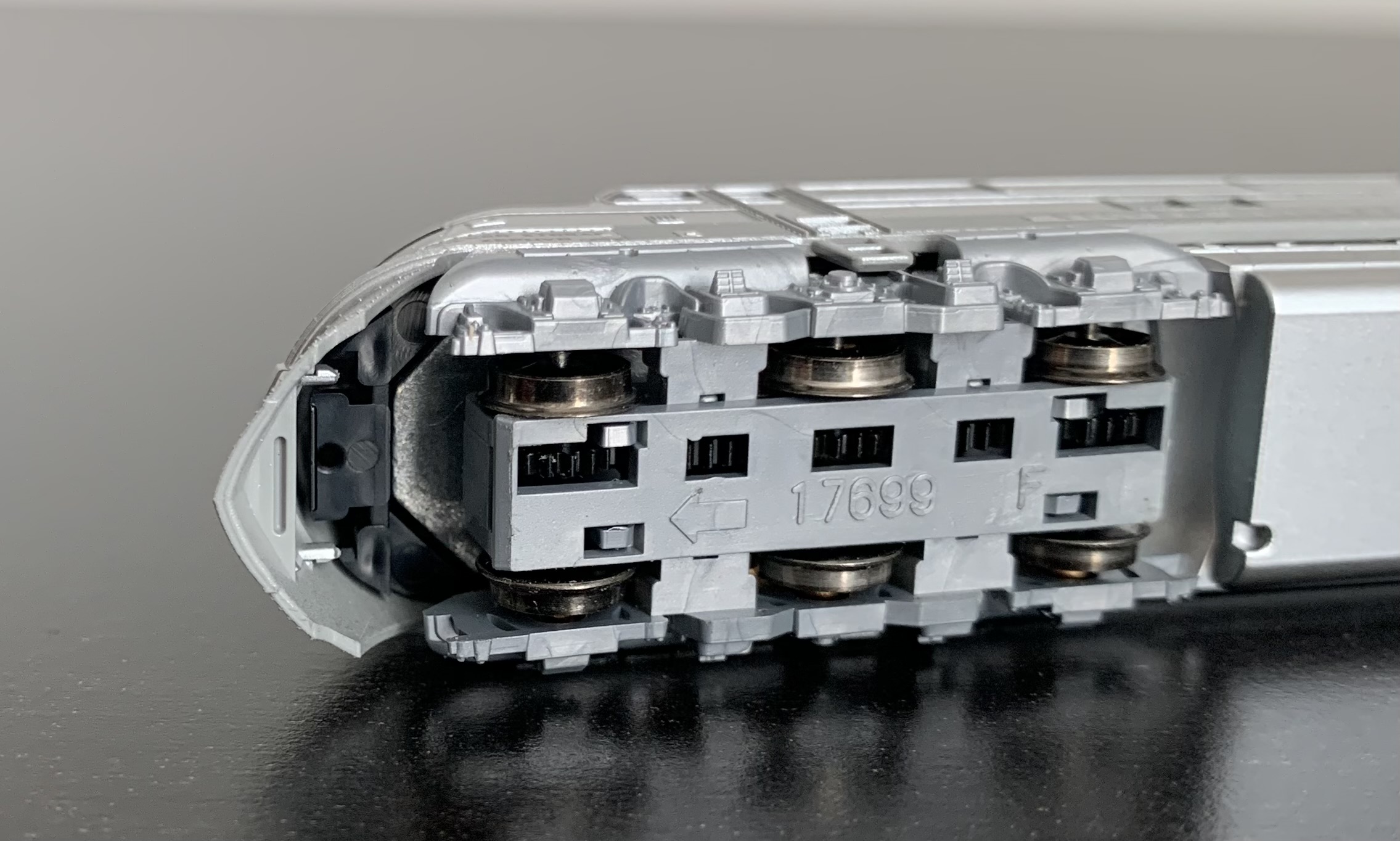
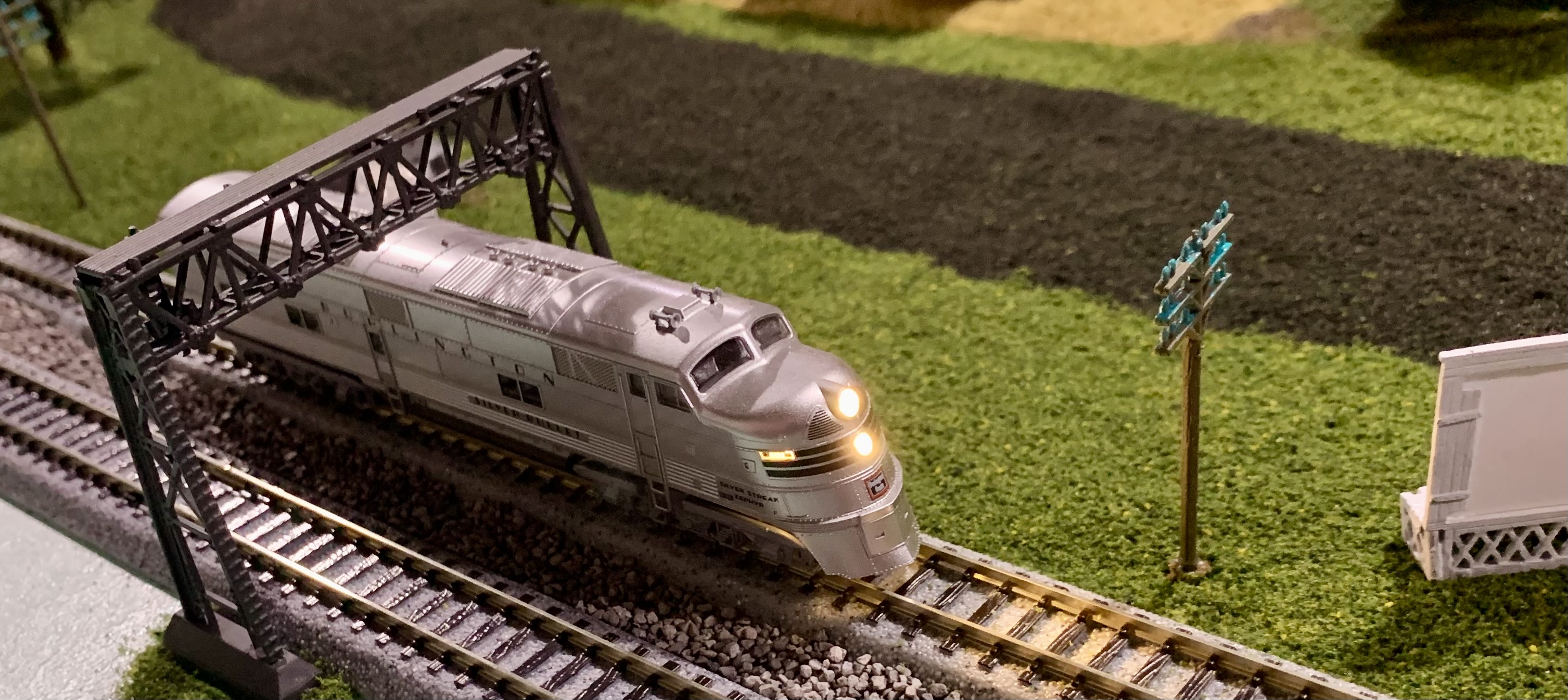
The plastic shell with split die-cast metal frame weighted a hefty 5 ounces and measured 5 ¼” in length. The Kato model is equipped with a powerful five-pole motor with dual brass flywheels. The all-wheel drive locomotive ran excellent at low and medium speeds on Kato Unitrack with no issues through turnouts. I ran my locomotive on 12” and 13” curves with no problems – but many recommend a minimum of 16”-18” curves for better operational appearance and to lessen the chance of derailment.
Kato Precision Railroad Models masterfully captured the elegance of this iconic American diesel locomotive. Striking color, excellent attention to detail, sharp tooling, and true representation from both eras of the Chicago Burlington and Quincy E5 engines. And course the solid reputation that Kato has earned for flawless running equipment that needs no adjustment to operate impeccability.
To see a list of all items in this series, CLICK HERE
Photo Credits:
Delano, Jack, photographer. Chicago, Illinois. The Chicago, Burlington and Quincy crack "Zephyr" trains leave from the south concourse of the Union Station. Feb. Photograph. Retrieved from the Library of Congress. No known restrictions.Delano, Jack, photographer. Chicago, Illinois. Unloading express from the Burlington Zephyr train at the Union Station. Jan. Photograph. Retrieved from the Library of Congress. No known restrictions.
Poster from the 1934 motion picture The Silver Streak. This work is in the public domain because it was published in the United States between 1928 and 1963, and although there may or may not have been a copyright notice, the copyright was not renewed.

